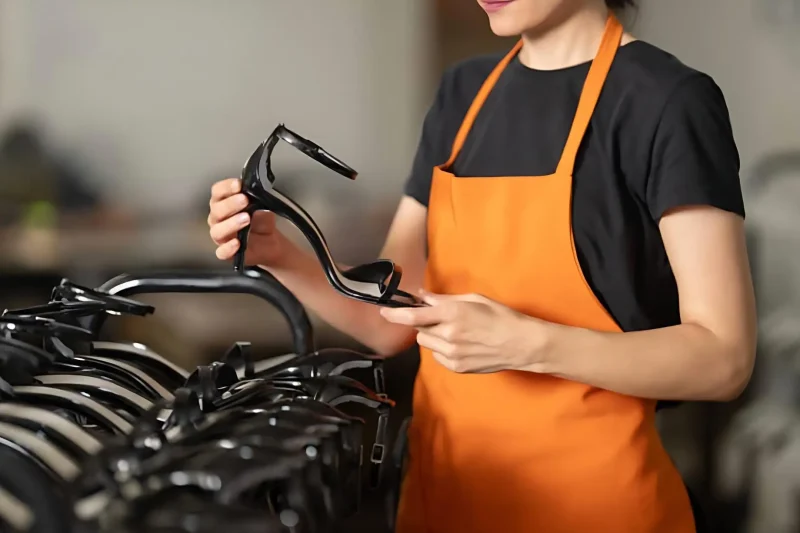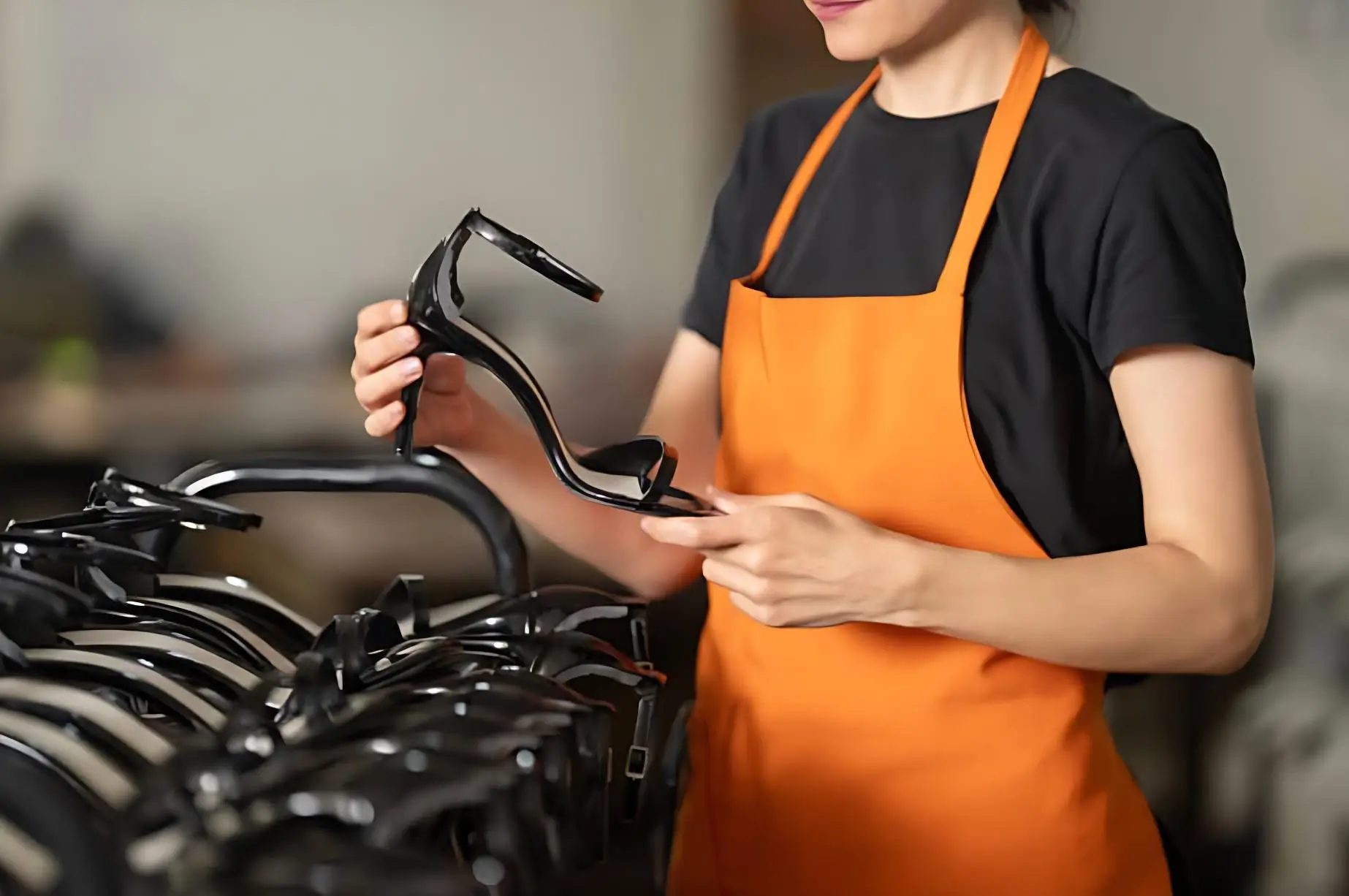As a brand owner, you have a vision on a sketchpad. It’s a great idea for a new boot, something you know the market wants. But how does that vision become a physical boot on a retail shelf? And more importantly, how long does that journey really take?
The traditional footwear development cycle is a long, winding road that can take up to 18 months. It’s a process filled with delays, endless physical samples, and a lot of uncertainty. I’ve spent over a decade in the footwear industry, managing this very process for global brands. I know the frustration.
But what if there was a better way? At JINHUA, we’ve engineered a high-velocity manufacturing model that can deliver a complex, custom technical hiking boot in just 90 days.
This is the sketch to shelf playbook. It’s a real-world, behind-the-scenes guide to our high-velocity custom OEM boot process. I’m going to pull back the curtain and show you exactly what happens at each stage, from a digital design to a product ready to ship.
The 4-Phase Framework for a 90-Day Production Cycle
To compress an 18-month timeline into just 90 days requires more than just working faster. It requires a complete rethinking of the entire shoe manufacturing process. Our model is built on a framework of four distinct, overlapping phases, each driven by digital technology and a philosophy of parallel processing.
Phase 1: Digital Design & Rapid Prototyping (Days 1-21)
This is where we build a perfect digital blueprint of your shoe, moving from concept to a production-ready technical package with incredible speed.
Phase 2: Concurrent Sourcing & Tooling (Days 15-45)
This is our secret weapon. We don’t wait. We initiate the longest lead-time activities—material sourcing and mold production—in parallel with the final stages of digital design.
Phase 3: Agile Manufacturing & Integrated QC (Days 46-75)
This is the 30-day mass production sprint, defined by flexibility and a system of quality control that is built into the line, not just checked at the end.
Phase 4: Proactive Logistics & Delivery (Days 76-90)
The final stage is all about a smooth, friction-free transition from our factory floor to your warehouse door.
A Deep Dive into the 90-Day Journey
Now, let’s go deeper into each phase. This is where you can see how digital technology and a different way of thinking make the 90-day timeline possible.
Phase 1 (Days 1-21): Digital Design & Rapid Prototyping
The initial 21-day phase is the most critical part of the entire process. The goal here is to achieve a signed-off, fully validated, production-ready digital technical package. We replace the old, slow, sequential process of physical sampling with a fully integrated digital workflow.
The Core Technology: The heart of this phase is the synergistic use of advanced 3D CAD software, like Romans CAD, with comprehensive digital material libraries. Instead of waiting for physical swatches of leather or fabric to be shipped, our designers and your team can work with hyper-realistic digital materials from libraries like Adobe Substance 3D. These are not just pictures; these are digital files that contain physically accurate data about the material’s color, texture, flexibility, and weight.
The Process: This allows us to create and visualize countless colorway and material package (CMP) combinations instantly on a 3D model of your boot. We can see exactly how a certain type of leather will look with a different colored outsole, without ever making a physical sample. We can even use integrated Finite Element Analysis (FEA) to simulate how a material will stretch or deform under stress, allowing us to optimize the patterns for durability and comfort before a single piece of material is cut.
The Business Insight: This “digital twin” approach is a game-changer for any private label footwear brand. It dramatically accelerates the design and approval process. Some platforms have shown that this can cut prototype costs by up to 70% and significantly reduce material waste. By Day 21, the output is not just a pretty picture; it’s a complete digital technical package. The CAD system automatically generates the Bill of Materials (BOM) and provides highly accurate pre-costing data, which can be fed directly into our ERP system. This validated digital blueprint becomes the single source of truth that triggers the next phase.
Phase 2 (Days 15-45): Concurrent Sourcing & Tooling
This phase is where our model truly breaks from tradition. This is our mastery of parallel processing in action.
The Traditional Way: Traditionally, a factory would never start ordering bulk materials or commissioning expensive tooling until the final, physical “golden sample” has been approved. This is a linear, sequential process that adds months to the timeline.
The JINHUA Way: We reject this slow, sequential logic. Leveraging the high-fidelity digital package and the accurate BOM from Phase 1, we initiate these critical path activities concurrently with the final stages of digital design, starting around Day 15 of the project.
The Process:
Material Sourcing: The accurate BOM is sent electronically to our pre-vetted network of Tier 2 suppliers. This allows us to immediately begin procuring the long-lead time materials, such as waterproof membranes, performance foams, or custom-dyed leathers. The precision of the digital specifications minimizes the risk of sourcing the wrong materials, giving us the confidence to commit to bulk orders much earlier in the process.
Tooling Production: Simultaneously, the final 3D CAD files for the sole unit (the outsole and midsole) are sent to our toolmaker to begin manufacturing the steel injection molds. This is almost always the longest lead-time item in the entire boot production process, often taking 30-60 days. By starting this process on Day 15, we ensure that the molds are ready for trial shots and final approval by Day 45, perfectly timed to align with the start of mass production.
The Business Insight: I know what you’re thinking: this sounds risky. What if there’s a late-stage design change? This is a valid concern. We mitigate this risk in two ways. First, the hyper-realistic 3D visualization in Phase 1 dramatically reduces the likelihood of major late-stage changes. Second, we have built deeply integrated, long-term relationships with our key suppliers, which allows for a degree of flexibility that is not possible in a purely transactional relationship.
Phase 3 (Days 46-75): Agile Manufacturing & Integrated Quality Control
With all the materials arriving at the factory and the tooling finalized and approved, the project now enters the 30-day mass production sprint. Our manufacturing philosophy during this phase is defined by two key concepts: agility and integrated quality control.
The Structure: Our factory floor is organized into flexible cellular manufacturing units. Instead of a single, long assembly line, we use self-contained teams that are responsible for specific stages of the assembly. This allows for greater flexibility and makes it much faster to identify and solve any bottlenecks that may arise.
The Technology: We use a real-time production monitoring system. This system tracks the output of each cell, monitors the performance of key machines, and flags any quality deviations instantly. This data-driven approach allows our managers to address issues as they happen, which is absolutely critical when you are operating on an accelerated production schedule. Common defects in technical footwear—like improper sole bonding or inconsistent stitching errors—are proactively identified and corrected within the cell, which prevents the propagation of these errors down the line.
The People: Our Quality Assurance (QA) is not a separate department at the end of the line; it is integrated directly into the manufacturing process. Our experienced QA technicians are embedded within each production cell. They conduct regular, documented checks at every single stage to ensure material consistency and structural integrity.
The Business Insight: A high-speed production environment puts immense pressure on the workforce. We understand that preventing employee burnout is not just an ethical issue; it’s a critical factor for maintaining high-quality output. We mitigate this risk with supportive management, ergonomic work processes, and a company culture that values the well-being of our team. This is a key part of our commitment to ethical manufacturing and a core reason why we have been a BSCI certified factory for years.
Phase 4 (Days 76-90): Proactive Logistics & Delivery
The final 15 days of the journey are focused on the smooth and efficient transition from our factory floor to the retail shelf. Our methodology here is all about proactive logistics management.
The Partnership: A key strategy we use is partnering with a Non-Vessel Operating Common Carrier (NVOCC). NVOCCs are logistics experts who consolidate cargo from multiple companies. This gives them significant leverage to negotiate better rates and, more importantly, to secure guaranteed space on container vessels. This is a major advantage, especially during peak shipping seasons.
The Process: The cornerstone of this phase is digital documentation and customs pre-clearance. While your boots are being carefully packed into shoeboxes and cartons, our logistics team is already digitally preparing and submitting all the necessary export and import documents (like the commercial invoice, packing list, and bill of lading). By submitting these documents to the customs brokers at the destination port before the vessel even departs, the shipment can often be pre-cleared by the authorities. This proactive measure is the key to minimizing delays at the port and avoiding costly demurrage charges.
The Business Insight: This highly efficient, digitally-enabled process is standard for us. However, it’s important for brand owners to understand that a 90-day model has very little buffer for unforeseen global disruptions, like a major port strike or a canal blockage. This is why meticulous planning and a strong partnership with your logistics provider are so critical.
A JINHUA Case Study: Bringing a Custom OEM Boot to Market in 82 Days
To show you this isn’t just theory, let me walk you through a real-world example of our 90-day model in action.
The Client & The Challenge: An emerging European outdoor brand approached us with a challenge. They had a fantastic, but technically complex, design for a new waterproof hiking boot. Their previous supplier had quoted them a 12-month development and production timeline, which would cause them to miss an entire critical selling season.
Our 90-Day Solution: We immediately put their project into our high-velocity model.
Days 1-21: Our teams worked collaboratively with the client in Romans CAD to finalize the design, test different digital materials for performance, and lock in the colorways.
Day 15: Based on the validated digital blueprint, we commissioned the complex, multi-density TPR/EVA outsole molds from our long-term tooling partner and placed confirmed orders for the waterproof membrane and other long-lead time materials.
Day 46: The first finished boots started coming off the assembly line. Our embedded QC team was on-site, checking every stage.
Day 78: The final random inspection was conducted by the client’s chosen third-party inspector and passed with an AQL of Major 1.5.
Day 82: The container was loaded, sealed, and on its way to the port.
The Result & Client Testimonial: The client received their product with two full weeks to spare before their scheduled launch date. The boot was a commercial success, and they have since become one of our most valued long-term partners. As their Sourcing Director put it, “JINHUA didn’t just make our product; they saved our season. Their speed and transparency are unlike any other partner we’ve worked with.”
This is the power of a streamlined, digitally-driven footwear production process.
Frequently Asked Questions
1. Is a 90-day timeline realistic for every custom boot?
It is realistic for most technical and casual boots. However, the timeline can be affected by the complexity of the design and the availability of highly specialized or custom-developed materials. We will always provide a clear and realistic timeline after reviewing your tech pack.
2. What are the risks of this high-velocity model?
The main risk is that the compressed timeline allows for less buffer for major, late-stage design changes. This is why the intensive digital design and approval process in Phase 1 is so critical. We work to resolve all design questions before we commit to materials and tooling.
3. Who owns the molds if I pay for them?
You do. Unambiguously. You paid for the tooling, so it is your exclusive property. Our contract clearly states this, and we will never use your private mold to make shoes for any other brand.
4. What is the most common cause of delays in the sketch to shelf process?
From my experience, the single most common cause of delays is slow or unclear feedback from the brand during the sampling and approval phase. In our 90-day model, timely and decisive feedback is crucial to keeping the project on schedule.
5. What information do I need to provide to get started with this 90-day model?
The best way to start is with a detailed tech pack. However, even if you just have a collection of detailed sketches and reference images, our team can work with you. We can help you to develop a professional tech pack and guide you through the entire process.
Final Takeaways: Ready to Start Your Own 90-Day Journey?
I hope this guide has given you a clear and transparent look into how a modern custom shoe manufacturing process can work. The sketch to shelf journey doesn’t have to be a long, unpredictable, and frustrating process.
Here are the most important takeaways to remember:
Digital is the Key: A fully digital design and prototyping phase is the single biggest factor in achieving incredible speed-to-market.
Concurrent Processing is a Superpower: Don’t wait. A great partner will have the confidence and the systems to start sourcing materials and making tools in parallel with the final design stages.
Quality Must Be Integrated, Not Just Inspected at the End: Quality can’t be a final step. It must be a part of every single stage of the manufacturing process.
Proactive Logistics Saves Time and Money: Planning your shipping and customs clearance well in advance is crucial for hitting your delivery dates.
Partnership is Everything: This high-velocity model only works with a deep, trusting, and transparent partnership between the brand and the manufacturer.
At JINHUA, we have perfected this high-velocity model. We are experts in turning your vision into a reality, efficiently, and with the highest possible quality standards. We are not just your supplier; we are your partner in growth.
Got a project in mind? Let’s turn it into reality.
You can start the conversation by reaching out to our expert team through your preferred channel below.
📧 Email: sales@jinhuashoes.com
(You’ll get personalized, expert feedback within 12 business hours.)



